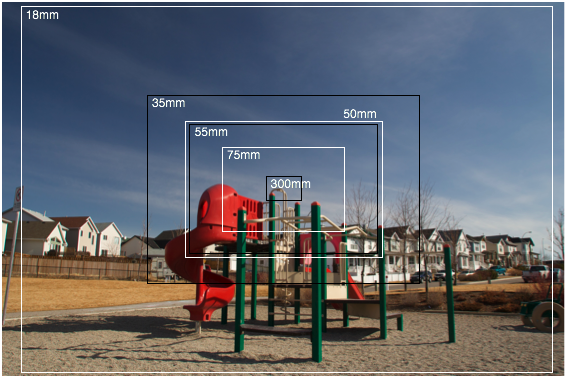Focal length is the factor determining how much “zoom” you get when taking a photo. Larger numbers mean longer lenses, meaning closer zoom. But, if you have a couple of lenses, it’s sometimes hard (at least initially) to figure out which lens to use for which shot. With a point-and-shoot, it’s easy, because there’s only one lens, and it’s built in. The only control you have is over the level of zoom. With a DSLR, you can swap the lenses out, which gives a great deal of flexibility, but means you need to put some thought into what range of focal lengths you want to have handy.
Here’s an example shot, taken at a playground near my house. I shot a “wide” photo at 17mm (on a Canon 17-35mm L USM), and took corresponding shots at various key focal lengths on the other lenses in my kit.

18mm is the widest that the Canon 18-55mm kit lens will go, and is likely the widest angle most people will have available without spending a whole bunch of cash (which I haven’t done yet). 35mm is the long end of that L lens. 55mm is the longest that the kit lens will do, so that gives a pretty decent walking around range of focal lengths. The 50mm (shot with my Canon 50mm f/1.8 II) is pretty close to the long end of the kit, but the image was much sharper with the 50mm prime. The 75mm was shot with the wide end of the Canon 75-300mm USM II, and the 300mm was at the long end of that lens.
So the kit lens actually has a pretty decent range of focal lengths for regular use and landscapes. It’s not long enough to pull details out of things very far away, but does pretty well. It falls down miserably on its aperture range - it’s a pathetically slow lens, meaning it’s only really good for bright conditions (outdoors, or brightly lit indoor settings).
The Canon 50mm prime lens is actually the one I use about 90-95% of the time. You can see that it is not very wide - you’re not going to capture sweeping panoramas with it - but I love this lens for two reasons. First, it’s great at capturing the central focus point of a scene - the part that you are really looking at when you’re not peeking through the camera. Many people say 35mm is “normal” but for me, 50mm feels much closer. Maybe that’s a hint to visit my eye doctor again… The second reason I love the 50mm prime is that it is a fast lens. In this case, “fast” doesn’t refer to the speed of the lens, but at how it gulps light in through a wide aperture (the opening inside the lens that lets light through), letting the camera take pictures with a faster shutter opening. Yeah. It’s not exactly intuitive. Fast lenses are really “wide aperture” lenses, and they’re called fast because they let the camera take pictures with less exposure. Slow lenses (like the Canon 18-55mm kit, or the 75-300mm) are still great for outdoors, scenery, or even night shots with a stable enough tripod and a long exposure. It’s not necessarily a bad thing, just something to keep in mind when picking the lens to use. I typically pick my 50mm f/1.8 lens because it’s so ungodly fast that I don’t need to use a flash even in relatively low light (especially if cranking the ISO to 1600).
Another lens that I’ve used is the Canon 28-135mm USM IS. It’s a great lens (we picked it up for the office) and I believe now ships as a kit option on the Canon XTi. I didn’t have the lens with me when I shot these test photos, but it should be pretty straightforward to see where the 28mm and 135mm ends of the range fit in - 28mm should be a bit wider than the 35mm box in the image above, and 135mm should be roughly halfway between the 75mm and 300mm boxes.
So, with a bunch of lenses in a photo kit, how does one pick the right one for the job? I came up with 2 handy tricks to help me pick. It should be noted that these tricks are calibrated for the length of my arm and hand, and for the 1.6 crop factor of my Canon XT.
First, if I’m thinking about shooting something far away, I just hold my hand up at arm’s length, like this:
The part of the scene that spans the first two knuckles of my finger are roughly what will be captured at 300mm. Makes it easy to see if a small/distant item will fit, or if 300mm will be enough. 75mm is roughly the span between the thumb joint and fingertip.
For 50mm, I came up with a quick test. Just make a shaka at arms length, like this:
The part of the scene that spans my thumb and pinky is roughly what will be captured at 50mm. Plus, it’s fun to make the shaka when composing a scene. (total aside: when swimming at Ala Moana Beach in Honolulu, a local woman shared the story behind the shaka. Picture the shape of a humpback whale’s tale as they make a dive. It comes out of the water, looking very much like my hand in the photo above. Shaka is the whale’s tail.)
Of course, with enough practice, these tips become unnecessary as you begin to judge what will be captured at various focal lengths automatically. But they can be a very handy shortcut, especially when learning to use a new lens or two.


Comments powered by Talkyard.